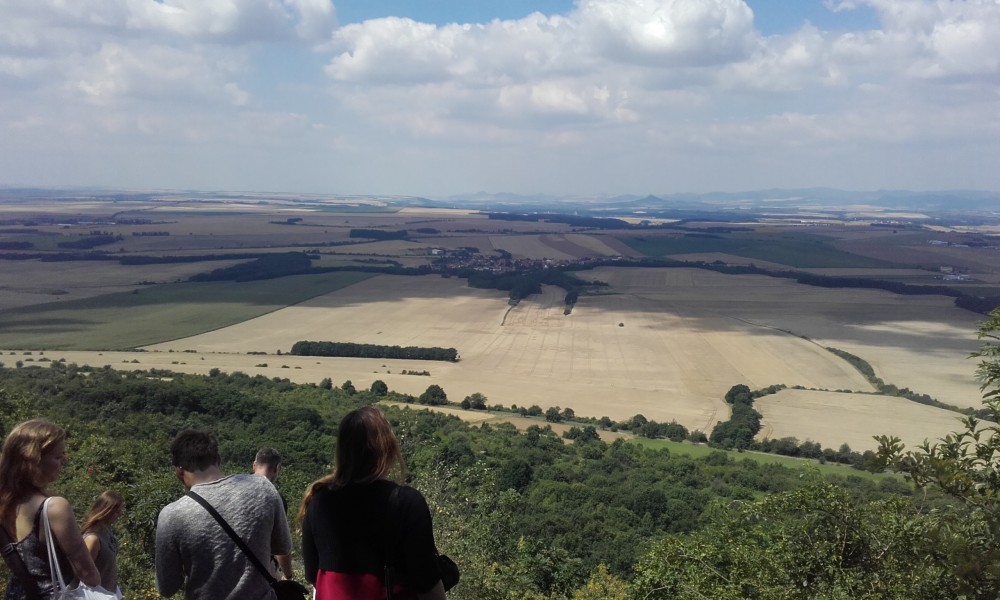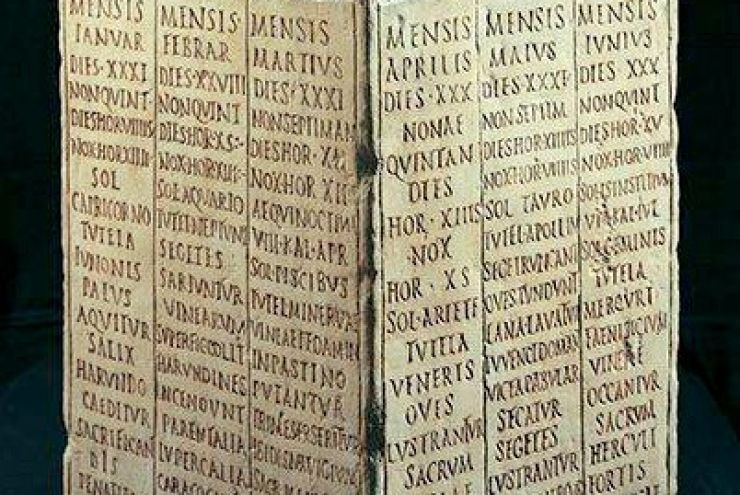
Scripsit Forī Hadriani, a.d.III Idus Dec, MMDCCLXIX aUc.
How does the compass app of the Smartphone work?
I was trying to forget the question and to relax, while I was proceeding along a narrow path, inside the shadowy wood of the Říp mountain, in the Northern Bohemia, around 40 km north of Prague. Summer sunshine was hardly filtering through leafy branches, while footsteps were swallowed by leaves. I was in an excursion with a group of roughly thirty people, attending the conference of the ECER -European Congress of Ethnic Religions. We were proceeding in an unnatural silence, with a feeling of expectation.
Well, the compass. A quarter an hour earlier, while we were near the 12th century Romanesque chapel of St. George, built on a preexisting pagan ruin, a “frater” showed me that the compass of his smartphone was turning round and round, in a hypnotic way. The rational part of me immediately reacted with the question: “How does the compass app of the Smartphone work?”. Was it actually an anomaly of the magnetic field or rather was the phone out of coverage? The answer depended on the way of working of the app. The more we were venturing into the forest, the more my rational part was urging for any logical handhold, to prevent tottering, and was confusedly grabbing any consistent though, fading little by little to a single mantra repeated over and over: “How does the compass app of the Smartphone work?”
Suddenly the green curtain opened in front of me on the strong midday sunshine of June and, as soon as I recovered from the dazzling change of light, I admired a spectacular view: a sublime country landscape with meadows and fields, hills and woods extended till to the horizon. My shipwreck was complete. My rational mind was amused.
I withdrew a few meters from the group, to be more concentrate, while somebody was dedicating a prayer to the god Perun in Czech. At a certain point during the ritual, all of us raised the hands toward the sky. I was invoking Jupiter to myself, the god of my ancestors. Precisely in that moment I saw her, materialized out of nowhere, a wonderful eagle gliding in the high blue sky over our heads. She drew a large turn, almost in a slowly motion, and then she confirmed it with a second turn, and then one more, pointing suddenly upward and disappearing as quick as she had appeared. Gone. Every though of mine was in a deep silence, in awe. Jupiter’s eagle had flown over our heads during the invocation.
Which is the nature of the immortal Gods? The classic world has provided many answer to this question that probably is so ancient as the human been. The plurality of answers is in line with the variety of the ancient philosophical tradition and its freedom of thought, exceptional in those times and achieved again only in the recent history. Actually, if on the one hand the religion was more oriented toward the orthopraxis, that is the correct execution of rituals, on the other hand the inclination to the philosophic investigation fostered the development and the coexistence of many theological interpretations. We can expect the formulation of completely different approaches to the problem since very ancient times. For instance Cicero, in his work “dē Naturā Deōrum” written in 44 BCE, presents three very different theories. The first one is related to the epicurean tradition and affirms that the Gods are not interested in human events and that they exist in a dimension that is completely disconnected from ours, so that any religious effort is useless. The second one, which looks to be preferred by Cicero, belongs to the stoic tradition that believes that human souls are immortal and that can be helped by the Gods’ providence. The third one eventually is atheistic and rationalistic, and consider the religion just as a political means to exercise the power, denying the existence of any divine dimension.
The theological interpretation of neoplatonic philosophy has a great influence on the modern polytheism. Neoplatonism, which is a development of the philosophy of Plato, bloomed in the whole Roman Empire starting from the 3rd century CE, in particular in Rome with the school of Plotinus, and in the whole Hellenistic world with philosophers like Iamblichus, Porphyry, the Emperor Flavius Claudius Julian and, later in the fifth century, the excellent mind of Proclus, the pagan saint. These authors consider the Gods to be metaphysical being. People’s souls can rise up to divinity following a right ethic, celebrating Gods by rituals and by theurgy, as ritualistic meditation technique.
 After the fall of Western Roman Empire, the neoplatonic pagan tradition survived in the Eastern Roman Empire, never completely eradicated (John the Lydian is a witness in the 6th century) in spite of the violent repression of the Christian theocracy, and the it was introduced again in Italy at the beginning of the Renaissance by Georgius Gemistus Pletho, a Byzantine scholar of Neoplatonism who was promoting a reformed pagan religion and who persuaded Cosimo de’ Medici to follow and support the platonic philosophy. As a consequence, the Florentine Platonic Academy was found, which boosted Renaissance humanism and let Neoplatonism be influential till today.
After the fall of Western Roman Empire, the neoplatonic pagan tradition survived in the Eastern Roman Empire, never completely eradicated (John the Lydian is a witness in the 6th century) in spite of the violent repression of the Christian theocracy, and the it was introduced again in Italy at the beginning of the Renaissance by Georgius Gemistus Pletho, a Byzantine scholar of Neoplatonism who was promoting a reformed pagan religion and who persuaded Cosimo de’ Medici to follow and support the platonic philosophy. As a consequence, the Florentine Platonic Academy was found, which boosted Renaissance humanism and let Neoplatonism be influential till today.
Which is the nature of the immortal Gods? Roman Tradition answers that there are several theological interpretative approaches, developed by eminent minds of the past, however they are not a dogma or a bond imposed to practitioner. Therefore, Neoplatonism does not correspond to Religio Romana, but provides an excellent tool to whom wishes to examine in depth pagan theology.
Religio Romana is practical and tangible rather than theoretical, since its origins. The core of Roman Religion, as founded by Numa Pompilius the second king of Rome, is a pact with the Gods, the Pax Deōrum (Gods’ Peace), “which is not only directed to the religious peace, but also to the social and political peace (equivalent, according to Roman custom), based on ritual execution” (reference 1).
The preferred way to know the immortal Gods is by direct experience of their manifestations rather than by theoretical speculation. According to the historian Varro (reference 2), Romans did not make any representation of their Gods for at least 170 years after the foundation of the City. Just later, under the influences of the Etruscan and Greek civilizations, Romans started representing their principal Gods in anthropomorphic way, however without developing for them so detailed characteristic as Greeks used to. For instance, the Italic god Janus was a preeminent god in Roman Religion, however the mythology about him is rather scarce. It is like if the lack of mythology promotes a direct experience, which in this case occurs on New Year’s Day when Janus opens the door of the new year (January means month “of Janus”), or when he opens every new month or even every new day. We meet Janus during unraveling of time, a dimension that seems to proceed from eternity and that mysteriously drag all of us in the direction indicated by entropy in modern physics.
Direct experience of divine manifestation has been the basis of the knowledge on the Gods, since the dawn of time. Although most of Gods’ names have not an understood etymology, Jupiter, or Iuppiter – Iovis Pater – has a clear Indo-European origin. The root of Iuppiter is di̯eu (“to blaze, to shine”): name that is found in most of the Indo-European dialects, because not only the Greek Ζεὺς πατήρ correspond to the Sanskrit Dyauḥ pitā and to the Italic Iuppiter (Umbrian Iupater, Iuve patri; also the Latin Diespiter), but the divinity of light is found from the same root also in Celtic, Germanic, Lithuanian (reference 3). Dating techniques confirms that Proto Indo-European was spoken at the beginning of the 5th millennium BCE (reference 4) and confirm in this way that our ancestors identified the God that today we know as Jupiter already seven thousand years ago. Currently the lack of written documentation or other evidences does not allow as to make any educate guessing for a time earlier than that. It is anyway surprising how Romans could realize the close affinity between their Gods with their neighbors’ ones. The direct experience of the manifestation of father Jupiter revealed is true transnational and universal nature. Many centuries later, Indo-European linguistic confirms with a scientific investigation that the names of Zeus and Jupiter are connected to the very same root.
The direct experience of the divine, based on intuitions and reality interpretations, is the key of the Religio Romana. In the same way, while my Czech friends were invoking the God Perun, I felt that for some mysterious reason Jupiter was there. The follower of the Roman Tradition is exposed to the divine manifestation and participates to the realization of the Pax Deōrum, by intuitively grasping the nature of the immortal Gods and acting in the world accordingly.
There are many possible answers about the nature of the immortal Gods. Surely we deal with a universal nature that sometimes is manifested with various types of phenomena, from simple intuitions to evident manifestations.
The App of the compass is based on magnetic field sensors that are integrated to the smartphone. Hence, the compass of the mobile is directly measuring a real physical entity. The Říp mountain is a volcanic hill that presents a high concentration of magnetite and a measurable anomaly of the magnetic field. As it is an isolated mountain, it is quite normal that it has been chosen by ancient populations as a sacred place.
That day the eagle of Jupiter flew propitious over our heads. Ita est.
Mario Basile
1) La religione dei Romani – Renato del Ponte.
2) Religions of Rome – Mary Beard, John North, Simon Price
3) Enciclopedia Treccani della Lingua Italiana (free translation).
4) Indo European Origins – William G. Davey.
















